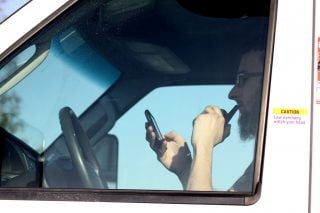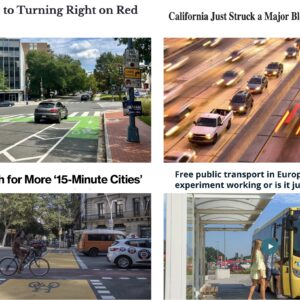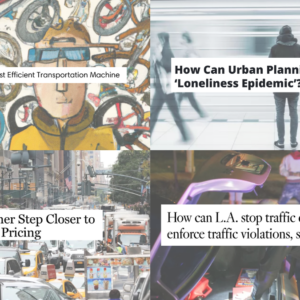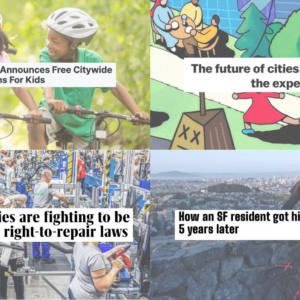
(Photo: Lord Jim)
And we’re back! BikePortland’s vast news empire (both of us, that is) is back in town and ready to kick things off with the bike-related links from around the world that caught our eyes this week:
Blocking texting: A little black box plugged into your steering column can jam your phone while you’re driving so you’re not tempted to use it.
Playable cities: Public waterslides, chalkboard storefronts, live citywide zombie games; the city that plays together stays together, writes The Guardian.
“Officer Joker”: A single Seattle bike cop has written 80 percent of all the city’s citations for public marijuana use.
Toll us, please: 79 percent of U.S. residents would support adding tolls to more highways “if it resulted in a safer, congestion-free and more reliable trip.”
Expensive bike share: The trend of the year in bike share systems, at least unsubsidized ones, is significantly higher prices: $125 a year and $15 a day in San Diego.
Portland’s identity: Miss Oregon 2014 (Rebecca Anderson of Oregon City) wore a bike helmet and shoes with tiny bicycle figurines on them during a Miss America shoe parade.
Licensing requirements: Getting a driver’s license in Germany requires 3 to 6 months of study and thousands of dollars in fees. (video)
Advertisement
Bridge bike lanes: Pittsburgh used some mobile plastic posts to prove last week that it’s really not that hard to test them. (video)
Free parking: “If we make conditions for cycling pleasant, people will choose to cycle even if parking is cheap or free,” writes David Hembrow, armed with pictures of half-empty parking lots in a small Dutch city.
Parking-free prosperity: In the 15 years since Los Angeles killed its rule that auto parking be added during remodels of old downtown buildings, it’s added 20,000 new housing units, a fifth of all new development.
Klein’s next move: Transportation reformer Gabe Klein has a new job — chief operations officer of a startup that operates upscale private urban bus lines.
Mapping street space: Copenhagenize color-codes semi-random overhead photos from Paris, Calgary and Tokyo to show how much space is dedicated to cars and how much is actually occupied by cars.
Institutionalized progress: The federal Department of Transportation is about to release “a road diet guide, an environmental justice handbook, and a cycle track design guide.”
Federal cash: 72 new federal TIGER grants dropped last week. (The Portland area’s winner: $10 million for digital tools to increase Washington County road capacity.)
The singleton surge: Since 1940, the share of U.S. households that consist of one person has more than tripled, to 27 percent. It might be the biggest single factor behind rising suburban poverty.
What do you get when an English town tears all the traffic signals and stripes out of its hectic central intersection in favor of narrowed entrances and textured pavement? One very inspiring video of the week:
If you come across a noteworthy bicycle story, send it in via email, Tweet @bikeportland, or whatever else and we’ll consider adding it to next Monday’s roundup.







Thanks for reading.
BikePortland has served this community with independent community journalism since 2005. We rely on subscriptions from readers like you to survive. Your financial support is vital in keeping this valuable resource alive and well.
Please subscribe today to strengthen and expand our work.
Bridge bike lanes link points to German license requirements page.
Is this it:
Bike lanes coming to 3 bridges in Pittsburgh?
Sorry, it’s this one:
http://www.streetfilms.org/need-a-bike-lane-on-a-bridge-might-want-to-experiment-with-what-pittsburgh-did/
Ideas used to improve the safety and practicality of biking, and support people’s willingness to ride, considered in David Hembrow’s article: http://www.aviewfromthecyclepath.com/2014/09/does-free-car-parking-make-people-drive.html?utm_source=feedburner&utm_medium=feed&utm_campaign=Feed%3A+AViewFromTheCyclePath-DavidHembrow+%28A+view+from+the+cycle+path+-+David+Hembrow%29
…are so smart and logical. Washington County, and cities within it such as, Beaverton, Hillsboro, Tigard, could have better success meeting their transportation objectives if they were to design and build infrastructure supportive of biking as described in this article. Portland as well. Lack of infrastructure in Portland, that supports people biking as well as does infrastructure described in the article, could be the single greatest reason the number of PSU students riding to and from the university, is dropping.
it’s not so much the cost of parking but the *scarcity* of parking in central cities that has helped promote and maintain high bike mode share in the netherlands. in dutch suburbs and rural areas bike mode share is far lower than in urrban areas.
Re: Poynton; if this is what it takes to get people to consistently use turn signals (notice the difference in the video), I suggest we do this to all intersections in America.
Agreed! This is so cool… if more intersections were like this people would have to pay attention while they drive. I’m sure it would drastically cut down on the number of collisions of all types.
From “Trying to Hit the Brake on Texting While Driving”:
“The lure of the device is too powerful, he said, to be overcome by awareness of the risks.” —Dr. Paul Atchley, Director of the Cognitive Psychology Program, University of Kansas
We must truly be wired for addiction. “Would you rather die or ignore a text message?” “I’ll take death, please!”
“No, cake! Cake! Cake, sorry. Sorry…”
+1 for the Eddie Izzard reference.
I think that modern vehicle safety features change this equation slightly to “would you rather ignore a text message or risk the life of someone else ( vulnerable road user).”
Heh, yeah, you’re closer to the truth there. I guess if the choice is between ignoring a text and possibly killing someone else, it’s an easy decision. We need to make it a harder decision. If we could just find some way of making drivers feel the same degree of risk they impose on others…
What’s the difference between these two scenarios?
A. Man accidentally kills neighbor with shotgun.
B. Man accidentally kills neighbor with water balloon.
Killing someone with a water balloon would be a freak occurrence with an object that is generally considered safe.
Killing someone with a gun is a more regular occurrence in the US, to the tune of 32,000 people in 2011 (roughly the same as automobiles). We know that a shotgun is a dangerous object, and needs to be handled with care by someone who knows what they are doing. Why don’t we know that about cars?
Too many people think of cars like water balloons, where accidents are mostly freak occurrences. That’s why all of those silly excuses seem to make sense. Even the police seem to agree with this — how many times have we seen someone run down, and they just throw their hands up and say ‘s**t happens’?
Just saw on the news where a driver jumped a curb and ran down a teacher and three special needs students she was taking for a walk (Redwood City, CA). Immediately the interview with the school administrator began by asking them if they would no longer be taking the students on walks due to safety, or if they believed this was “just a freak accident.”
“…Too many people think of cars like water balloons, where accidents are mostly freak occurrences. …” Dan
I wouldn’t be surprised if you’re the only person that seriously compares cars to being like water balloons, or that collisions, if this is what you’re referring to with the word ‘accident’, are as unusual and infrequent as freak occurrences are.
Roadways on which motor vehicles, and actually, even bicycles, are known hazards which people generally understand and accept that there are risks associated with in using. Not the case with water balloons, except for wildlife having the misfortune of mistaking water balloons for food.
I think most people consider people’s use of cell phones while driving and other types of distracted, user justified abuse of driving, to exceed the range of known road use hazards they should be obliged to endure as road users. Even people that indulge in distracted driving, which undoubtedly has a lot to do with the fact that there’s been support for anti cell phone use measures taken.
Cell phone blockers installed in cars may be an idea to consider. There may be better ideas to come, to effectively and practically squelch distracted driving.
Most regular, ordinary, average driving exceeds my tolerance for safe driving behavior. I know people who regularly operate their vehicle with a single digit, or who drive with their knees on the freeway, or who treat the stop line at an intersection as a casual suggestion and stop 5 feet past it as a matter of habit. They operate their vehicle with just a FRACTION of the care that I use to operate my bicycle.
When driving through a neighborhood, you should have two hands on the wheel and a foot near the brake, driving at or below the speed limit with your eyes scanning for places where people or animals might suddenly step in front of you. How many people do this? 1 out of 10?
We have accepted a level of laziness with driving that results in certain number of deaths. We’re not going to adjust the number of deaths without adjusting our expectations of drivers.
“Most regular, ordinary, average driving exceeds my tolerance for safe driving behavior. …” Dan
It would seem you have a very low tolerance for safe driving behavior. Most people are driving safely, and through their driving behavior, are doing at least their part and often more, to keep vulnerable road users alive.
While you, as you describe yourself, may be a very alert, responsible road user when riding your bike, many people biking are not. Their behavior leaves people driving motor vehicles with hazards to avoid, just as people driving distracted and otherwise badly, pose hazards to other people using the road.
All people, as road users, are susceptible to distractions. Any realistic ideas for countering distractions may be worth considering. Vague, generalized suggestions of increased expectations of people driving aren’t likely to be much help. From this Monday Roundup, is a link to a video on how tough it is to get a driver’s license in Germany:
http://www.cnet.com/videos/top-5-differences-between-us-and-german-licenses/
Does what’s described in that video, offer realistic ideas for having people in the U.S. become better drivers?
I read somewhere that only recently has mobile device use displaced eating while driving as a leading cause of ‘accidents’, with “excessive speed for conditions” still reigning as the most-cited cause in police reports. Of course discussions like this are completely subjective as there are few concrete measurements of what “most people” believe, but long before cell phone prevalence, in-dash navigation, and vent-mounted tablet holders there were still over 40,000 Americans killed in ‘accidents’ and they’ve been the leading cause of death in American children (I forget up to what age exactly) for as long as I’ve been alive. To this day, even in the dense auto-centric California suburb where I live now, I still see speeding and unsafe turns and lane changes FAR more than I see people texting or talking.
I think Dan sums it up exceptionally well here.
“…I think Dan sums it up exceptionally well here.” Pete
Right or wrong, it’s easy to point fingers. Far more difficult to come up with realistic ideas for reducing the objected to behavior.
I wonder how Poynton corralled community will to make those amazing (and seemingly counterintuitive) changes. Maybe the USDOT’s new road diet guide and bike/ped initiatives will help city traffic engineers see similar possibilities for American towns.
Poynton? Whatever next? Remembering that, at base, roads (and towns)are for people, not vehicles? Ridiculous – you can’t trust people to do the right thing without coralling and herding them. Never seen anything so absurd in my life.
It’ll never work, you mark my words.
LOL!
Yesterday was my Nth lecture by a driver who gunned it to get around me only to stop at the red light 50′ away. I had taken the (first) lane as the bike lane was parked out with cars (legal at certain times of day in Sunnyvale) and there was a popular right turn coming up that merges with the bike lane (easier to keep RTOL uncorked at long light). He made a point to say it was dangerous for me to be in the middle of the lane rather than over more to the right. Why, so you can maintain speed and try to squeeze by me within a foot rather than have to pay attention and change lanes (which wasn’t really necessary anyway)? Was it dangerous because you didn’t actually see me and are therefore not actually lecturing me now? Counter-intuitive indeed! 😉
Rule 1:
person in car > person on bike
Human sacrifice, dogs and cats living together – mass hysteria!
The San Diego Bikeshare story fails to note that while Minneapolis is the cheapest bikeshare system, it only operates for part of the year. Thus people are paying less money, but also only getting about 7 months of access.
Had to look that one up… thanks!
3rd this has happened when I saw a cop talking on his phone while driving a cop car. This just pisses me off…